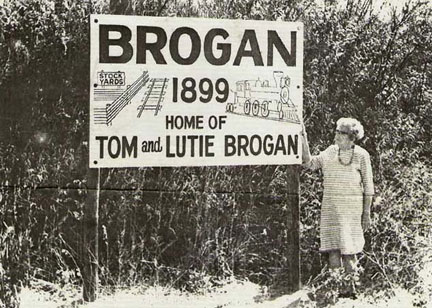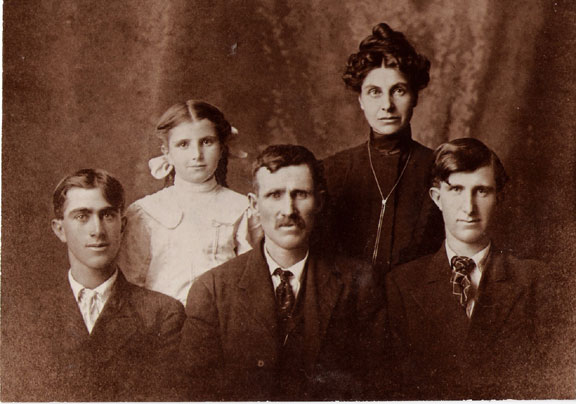History of Brogan, 1899 - ?
Agnes Christiansen, a Brogan Family Descendant
and
The road sign erected at the "official closing" of the town of Brogan in 1976
Brogan was located in the northwest section of Jackson Township, and it is one of the towns that slowly faded away in the history of Crawford County.
The Beginning
The Illinois Central prepared a roadbed for the railway in 1899 which started at Fort Dodge reached Brogan moved on to Ells, Denison, and finally, Council Bluffs. The company had designated Brogan as a shipping center, and a depot, section house, tool shed, and boxcars to serve as homes for workers appeared on the scene. Large stock yards were erected.
Lutie and Tom Brogan had just completed their spacious home on a nearby hillside before the railroad was built, and the Brogan family became quite involved as the consequence of the railroad's appearance.
Tom Brogan Family, ca. 1908
Back: Agnes Brogan Christiansen, Lou Erie "Luttie" Brogan
Front: James "Matthew" Brogan, Tom Brogan, and John Francis "Frank" Brogan.
Lutie Brogan served meals in her home for the freight train crews who worked on the trip from Council Bluffs to Fort Dodge. A telegraph system installed in the depot had an extension to the house, and the crews wired ahead from Missouri Valley from 10 a.m. to 10 p.m. to notify her of their arrival.
Rule of the house was a box of candy for the cook. A typical menu included two kinds of meat, two vegetables, potatoes, salad, home made breads and two kinds of pies. The price was 25¢ per plate.
Most of the produce was raised on the Brogan farm and it was preserved by canning, salting, drying and smoking and then stored in a large root cellar or cave. Lutie took the train twice a year to the city to buy boxes of staples including four or five hundred pounds of sugar.
The water for drinking and cooking had to be carried a quarter of a mile and the laundry was done using a water boiler, tubs, wash board and home made soap. All part of the "good old days".
Shipping fat cattle to market was not an easy task in those days since they had to be driven from the farms to the station. Hay and feed were brought along with the cattle, and the team and wagon with supplies usually preceded the herd.
Cattle took careful handling at all times to keep them from breaking away and escaping into adjacent fields. Hogs were more easily handled since they came by wagon.
Board floors of bridges encountered along the way baffled the animals. Gingerly stepping on the bridge they would usually crowd toward the center and break into a fast trot. Sound of their hoofs on the planks frightened them. They were very suspicious and skittish about crossing the tracks.
Those who did a large amount of shipping at the Brogan station included Winans, Meyers, Cooks, Christiansens, Schwanzs, Brothersons, Maynards, Simons, and others. Many of these families still have descendants in this area.
Brogan is now only a memory, and its history is preserved only in the memories of those whose families lived in the area in times past. The Boyer River still flows past, but only hillsides of trees remain, although in 1976 trains still passed by on their way to other destinations. It was in that year that the town was officially "closed" and a sign erected to commemorate its location.
Historical information and photos provided by Paula Curcio.




